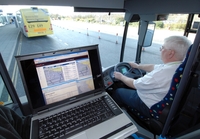TomTom WORK helps Bristol airport improve efficiency

Significant savings in fuel costs, lower emissions levels, and more efficient use of its vehicles are resulting from a pioneering use of TomTom WORK’s vehicle tracking and fleet management system at Bristol International Airport.
The system covers 21 vehicles and enables the airport to track the location and route taken by coaches carrying passengers to and from aircraft parked remotely from the terminal building, of car park shuttle buses, and of its fire tenders. It also identifies periods of excessive idling of the engines of these vehicles allowing the driver to be informed and the engine cut.
The result is that the airport is able to both refine the routes taken by the airside buses and reduce the overall mileage and to eliminate unnecessary engine idling. This is leading to less fuel consumption - and therefore a lower fuel bill - as well as making a valuable contribution to a cleaner environment by cutting emission levels.
The simple but highly effective solution provided by TomTom WORK involves the use of a LINK 300 ‘black box’ fleet management device fitted into each vehicle. This interacts with their WEBFLEET web-based software to provide real-time monitoring of airport vehicle movements. Other information of use to the airport can also be recorded by the web-based system and reports can be produced to help improve vehicle utilisation.
Steve Webb, Motor Transport Manager at Bristol International Airport, said: “A major area of energy consumption is the diesel used by our vehicles on the ground. As well as the environmental benefits of reducing the amount of fuel we use, there are also significant cost savings – especially important in these days of high fuel costs!
“Leaving the engine of a vehicle the size of an airport fire tender on idle for one hour each day - which can happen when, for example, a tender is on standby during a routine aircraft refueling – can cost up to £3,000 over the course of a year.”
The airport has also been able to use the system to build a case for investment in an air bridge to directly connect aircraft to the terminal building. Through WEBFLEET it has been able to capture and record valuable data on the number of vehicle movements and the time taken to load/unload an aircraft.
Jane Currie, Account Manager at LSUK, the TomTom Partner that supplied and installed the system, said: “Bristol International is the first airport in the UK to embrace this technology. It enables the airport to make more efficient use of its vehicles by ensuring optimum passenger loadings and improving route efficiency and could very effectively be employed at any large airport.”

